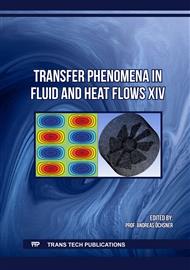[1]
Information on https://www.hopkinsmedicine.org/health/treatment-tests-and-therapies/deep-brain-stimulation.
Google Scholar
[2]
D.J. Aum and T.S. Tierney, Deep brain stimulation: foundations and future trends, Front. Biosci. 23 (2018) 162-182.
DOI: 10.2741/4586
Google Scholar
[3]
Y. Xiao, J.C. Lau, D. Hemachandra, G. Gilmore, A.R. Khan, and T.M. Peters, Image guidance in deep brain stimulation surgery to treat parkinson's disease: a comprehensive review, IEEE T. Bio-med. Eng. 68 (2020) 1024-1033.
DOI: 10.1109/tbme.2020.3006765
Google Scholar
[4]
A. Macerollo, V. Sajin, M. Bonello, D. Barghava, S.H. Alusi, P.R. Eldridge, and J. Osman-Farah, Deep brain stimulation in dystonia: State of art and future directions, J. Neurosci. Meth. 340 (2020).
DOI: 10.1016/j.jneumeth.2020.108750
Google Scholar
[5]
V. Salanova, Deep brain stimulation for epilepsy, Epilepsy Behav. 88 (2018) 21-24.
DOI: 10.1016/j.yebeh.2018.06.041
Google Scholar
[6]
I.E. Hamsen, G.J. Elias, M.E. Beyn, A. Boutet, A. Pancholi, J. Germann, A. Mansouri, C.S. Lozano, and A.M. Lozano, Clinical trials for deep brain stimulation: current state of affairs, Brain Stimul. 13 (2020) 378-385.
DOI: 10.1016/j.brs.2019.11.008
Google Scholar
[7]
J. Lam, J. Lee, C.Y. Liu, A.M. Lozano, and D.J. Lee, Deep brains stimulation for alzheimer's disease: tackling circuit dysfunction, Neuromodulation. 24 (2021) 171-186.
DOI: 10.1111/ner.13305
Google Scholar
[8]
R. Cubo and A. Medvedev, Online tissue conductivity estimation in deep brain stimulation, IEEE T. Contr. Syst. T. 28 (2018) 149-162.
DOI: 10.1109/tcst.2018.2862397
Google Scholar
[9]
L.C.S. Jardim, L.A.S. Abreu, D.C. Knupp, and A.J. da Silva Neto, Brain thermal and electrical properties estimation using experimental data from deep brain stimulation lead, Rev. Mundi Eng., Tecnol. Gest. 5 (2020).
DOI: 10.21575/25254782rmetg2020vol5n61349
Google Scholar
[10]
J.K. Krauss, N. Lipsman, T. Aziz, A. Boutet, P. Brown, J.W. Chang, B. Davidson, W.M. Grill, M.I. Hariz, A. Horn, M. Schulder, A. Mammis, P.A. Tass, J. Volkmann, and A.M. Lozano, Technology of deep brain stimulation: current status and future directions, Nat. Rev. Neurol. 17 (2021) 75-87.
DOI: 10.1038/s41582-020-00426-z
Google Scholar
[11]
C. McElcheran, L. Goestanirad, M. Iacono, P.P. Wei, B. Yang, K. Anderson, g. Bonmassar, and S. Graham, Numerical simulations of realistic lead trajectories and an experimental verification support the efficacy of parallel radiofrequency transmission to reduce heating of deep brain stimulation implants during MRI, Sci. Rep-uk. 9 (2019) 1-14.
DOI: 10.1038/s41598-018-38099-w
Google Scholar
[12]
A. Boutet, C.T. Chow, K. Narang, G.J. Elias, C. Neudorfer, J. Germann, M. Renjan, A. Loh, A.J. Martin, W. Kucharczyk, C.J. Steele, I. Hancu, A.R. Rezai, and A.M. Lozano, Improving safety of MRI on patients with deep brain stimulation devices, Radiology. 296 (2020) 250-262.
DOI: 10.1148/radiol.2020192291
Google Scholar
[13]
I.E. Harmsen, D.J. Lee, R.F. Dallapiazza, P. de Vloo, R. Chen, A. Fasano, S.K. Kalia, M. Hodaie, and A.M. Lozano, Ultrahigh frequency deep brain stimulation at 10 000 Hz improves motor function, Neurosurgery. 66 (2019) 310-367.
DOI: 10.1093/neuros/nyz310_367
Google Scholar
[14]
N. Khadka, I.E. Harmsen, A.M. Lozano, and M. Bikson, Bio-heat model of kilohertz-frequency deep brain stimulation increases brain temperature, Neuromodulation. 23 (2020) 489-495.
DOI: 10.1111/ner.13120
Google Scholar
[15]
L. Golestanirad, E. Kazamivalipour, D. Lampman, H. Habara, E. Atalar, J. Rosenow, J. Pilitsis, and J. Kirsch, RF heating of deep brain stimulation implants in open-bore vertical MRI systems: A simulation study with realistic device configuration, Magn. Reson. Med. 83 (2020) 2284-2292.
DOI: 10.1002/mrm.28049
Google Scholar
[16]
B. Davidson, F. Tam, B. Yang, Y. Meng, C. Hamani, S.J. Graham, and N. Lipsman, Three-tesla magnetic resonance imaging of patients with deep brain stimulators: results from a phantom study and a pilot study in patients, Neurosurgery. 88 (2021) 349-355.
DOI: 10.1093/neuros/nyaa439
Google Scholar
[17]
M.M. Elwassif, Q. Kong, M. Vazquez, and M. Bikson, Bio-heat transfer model of deep brain stimulation-induced temperatures changes, J. Neural Eng. 3 (2006) 306-315.
DOI: 10.1088/1741-2560/3/4/008
Google Scholar
[18]
M.M. Elwassif, A. Datta, A. Rahman, and M. Bikson, Temperature control at DBS electrodes using a heat sink: experimentally validated FEM model of DBS lead architecture, J. Neural Eng. 9 (2012).
DOI: 10.1088/1741-2560/9/4/046009
Google Scholar
[19]
C.R. Pereira, L.A.S. Abreu, D.C. Knupp, and L.C.S. Jardim, Estimation of the brain temperature in deep brain stimulation application with the particle filter method, In. COBEM 2021: 26th International Congress of Mechanical Engineering.
DOI: 10.26678/abcm.cobem2021.cob2021-1582
Google Scholar
[20]
Medtronic, and INC, DBS lead kit for deep brain stimulation, model 3387/3389, Implant Manual, Minneapolis, MN, US: [s.n.]. (2002).
Google Scholar
[21]
H.H. Pennes, Analysis of tissue and arterial blood temperatures in the resting human forearm, J. Appl. Physiol. 1 (1948) 93-122.
DOI: 10.1152/jappl.1948.1.2.93
Google Scholar
[22]
I. Chang, Finite element analysis of hepatic radiofrequency ablation probes using temperature-dependent electrical conductivity, Biomed. Eng. 2 (2003) 1-18.
DOI: 10.1186/1475-925x-2-12
Google Scholar
[23]
B. Lamien, L.A. Varon, H.R. Orlande, and G.E. Eliçabe, State estimation in bioheat transfer: a comparison of particle filter algorithms, Int. J. Numer. Method H. 27 (2017) 615-638.
DOI: 10.1108/hff-03-2016-0118
Google Scholar
[24]
I.M. Sobol, A Primer for the Monte Carlo Method, CRC Press, New York, 1994.
Google Scholar
[25]
R.Y. Rubinstein and D.P. Kroese, Stimulation and the Monte Carlo Method, third ed., John Wiley & Sons, New Jersey, 2017.
Google Scholar
[26]
D.A. Castello and T.G. Ritto, Quantificação de Incertezas a Estimação de Parâmetros em Dinâmica Estrutural: Uma Introdução a Partir de Exemplos Computacionais, v. 81, Notas em Matemática Aplicada, SBMAC, São Carlos, 2016.
DOI: 10.5540/001.2012.0035.01
Google Scholar
[27]
N.P. da Silva, L.A.B. Varon, J.M.J. da Costa, and H.R.B. Orlande, Monte Carlo parameter estimation and direct simulation of in vitro hyrthermia-chemotherapy experiment, Numer. Heat Tr. A-Appl. 80 (2021) 185-209.
DOI: 10.1080/10407782.2021.1940009
Google Scholar
[28]
J. Kaipio and E. Somersalo, Statistical and Computational Inverse Problems, v. 160, Applied Mathematical Sciences, Springer Science & Business Media, New York, 2006.
Google Scholar
[29]
P.A. Hasgall, F. Di Gennaro, C. Baumgartner, E. Neufeld, B. Lloyd, M.C. Gosseli, D. Payne, A. Klingenböck, and N. Kuster, "IT'IS Database for thermal and electromagnetic parameters of biological tissues", Version 4.1, Feb 22, 2022, DOI: 10.13099/VIP21000-04-1. itis.swiss/database/.
Google Scholar


